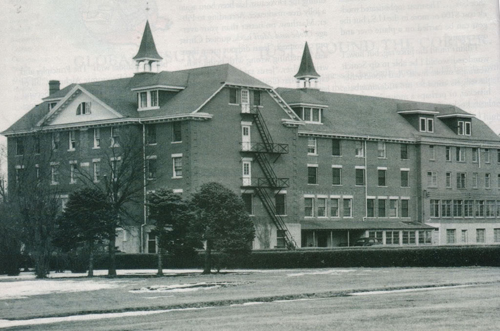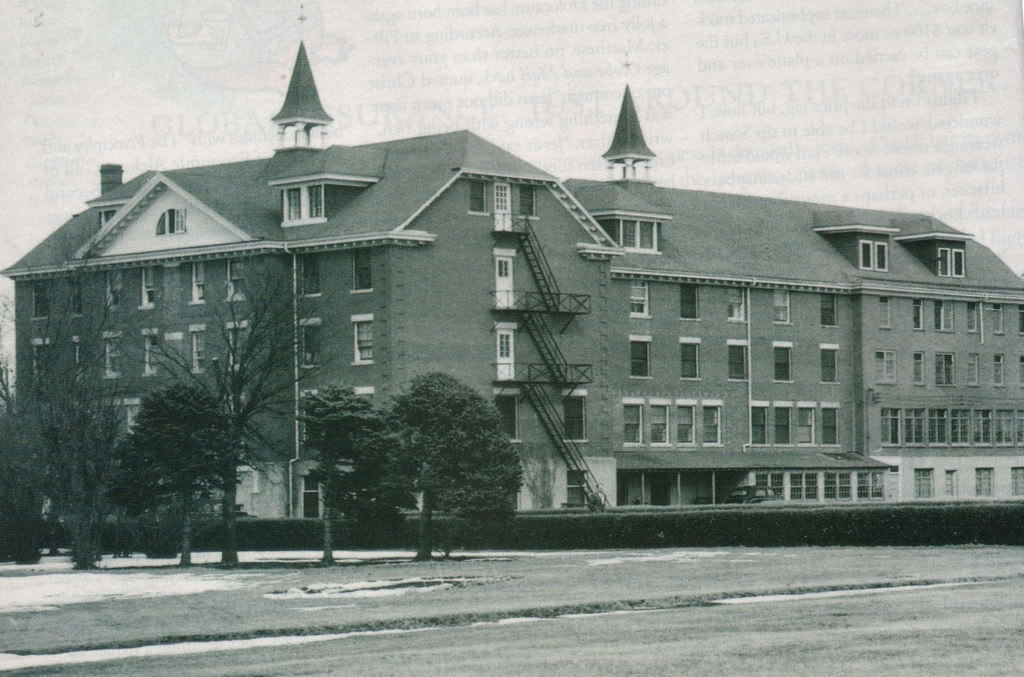|
Provincial Training School
The Provincial Training School (PTS) for what was then termed 'Mental Defectives' in Red Deer, Alberta, Red Deer, Alberta, Canada operated as an institution for mentally disabled children and adults between 1923 and 1977, at which time it was renamed the Michener Centre. It aimed to provide care and training to facilitate the integration of individuals with intellectual disabilities into their communities. While today it houses a service for persons with developmental disabilities, the nearly one-century-old facility is preceded by a diverse history, marked by eugenic practices like involuntary sterilization. History of the building The three-storey building, which once housed the Provincial Training School, has undergone many administrative changes since its construction in 1913. Located on the Michener hill in the city of Red Deer, Alberta, it originally housed the Alberta Ladies' College of Red Deer as one of Western Canada's finest residential college buildings at the time. ... [...More Info...] [...Related Items...] OR: [Wikipedia] [Google] [Baidu] |
Sexual Sterilization Act
In 1928, the Legislative Assembly of Alberta, Canada, enacted the ''Sexual Sterilization Act''. The Act, drafted to protect the gene pool, allowed for sterilization of mentally disabled people in order to prevent the transmission of traits to offspring deemed undesirable. At that time, eugenicists argued that mental illness, mental retardation, epilepsy, alcoholism, pauperism, certain criminal behaviours, and social defects, such as prostitution and sexual perversion, were genetically determined and inherited. Further, it was widely believed that persons with these disorders had a higher reproduction rate than the normal population. As a result, it was feared the gene pool in the general population was weakening. During the time the ''Sexual Sterilization Act'' was in effect, 4,800 cases were proposed for sterilization in the Province of Alberta, of which 99% received approval. Examination of sterilization records demonstrates that legislation did not apply equally to all ... [...More Info...] [...Related Items...] OR: [Wikipedia] [Google] [Baidu] |
Hospitals In Alberta
A hospital is a health care institution providing patient treatment with specialized health science and auxiliary healthcare staff and medical equipment. The best-known type of hospital is the general hospital, which typically has an emergency department to treat urgent health problems ranging from fire and accident victims to a sudden illness. A district hospital typically is the major health care facility in its region, with many beds for intensive care and additional beds for patients who need long-term care. Specialized hospitals include trauma centers, rehabilitation hospitals, children's hospitals, seniors' (geriatric) hospitals, and hospitals for dealing with specific medical needs such as psychiatric treatment (see psychiatric hospital) and certain disease categories. Specialized hospitals can help reduce health care costs compared to general hospitals. Hospitals are classified as general, specialty, or government depending on the sources of income received. A teachi ... [...More Info...] [...Related Items...] OR: [Wikipedia] [Google] [Baidu] |
Hospital Buildings Completed In 1923
A hospital is a health care institution providing patient treatment with specialized health science and auxiliary healthcare staff and medical equipment. The best-known type of hospital is the general hospital, which typically has an emergency department to treat urgent health problems ranging from fire and accident victims to a sudden illness. A district hospital typically is the major health care facility in its region, with many beds for intensive care and additional beds for patients who need long-term care. Specialized hospitals include trauma centers, rehabilitation hospitals, children's hospitals, seniors' (geriatric) hospitals, and hospitals for dealing with specific medical needs such as psychiatric treatment (see psychiatric hospital) and certain disease categories. Specialized hospitals can help reduce health care costs compared to general hospitals. Hospitals are classified as general, specialty, or government depending on the sources of income received. A teaching ... [...More Info...] [...Related Items...] OR: [Wikipedia] [Google] [Baidu] |
Leilani Muir
Leilani Marietta (O'Malley) Muir (July 15, 1944 – March 14, 2016), previously named Leilani Marie Scorah, was the first person to file a successful lawsuit against the Alberta government for wrongful sterilization under the ''Sexual Sterilization Act'' of Alberta. Her case led to the initiation of several other class action lawsuits against the province for wrongful sterilization. Muir's advocacy shed light on eugenics, institutionalisation, human rights for persons with a disability, and self-advocacy. Early life Muir was born in Calgary, Alberta, Canada into a poor family that frequently moved. She was an unwanted, unloved, and abused child. Her mother looked for ways to remove her from the family and, when Muir was eight, placed her in the Midnapore Convent for a month. Then, in 1953, her mother sent an application for Muir to be institutionalized at the Provincial Training School for Mental Defectives (also known as the Michener Centre) in Red Deer, Alberta. At that time th ... [...More Info...] [...Related Items...] OR: [Wikipedia] [Google] [Baidu] |
Down's Syndrome
Down syndrome or Down's syndrome, also known as trisomy 21, is a genetic disorder caused by the presence of all or part of a third copy of chromosome 21. It is usually associated with physical growth delays, mild to moderate intellectual disability, and characteristic facial features. The average IQ of a young adult with Down syndrome is 50, equivalent to the mental ability of an eight- or nine-year-old child, but this can vary widely. The parents of the affected individual are usually genetically normal. The probability increases from less than 0.1% in 20-year-old mothers to 3% in those of age 45. The extra chromosome is believed to occur by chance, with no known behavioral activity or environmental factor that changes the probability. Down syndrome can be identified during pregnancy by prenatal screening followed by diagnostic testing or after birth by direct observation and genetic testing. Since the introduction of screening, Down syndrome pregnancies are often aborte ... [...More Info...] [...Related Items...] OR: [Wikipedia] [Google] [Baidu] |
Leonard Jan Le Vann
Leonard Jan Le Vann (1 August 1915 – 29 September 1987)Le Vann, L. J. (n.d). Medical History. Red Deer Archives was the medical superintendent at the Alberta Provincial Training School for Mental Defectives (also known as the Michener Center)Heather Pringle. (1997, June). Alberta barren. Saturday Night, 112(5), 30-39. Retrieved March 29, 2011, from CBCA Reference and Current Events. (Document ID: 123821) from the years 1949–1974. Although he was born and raised in the United States, Le Vann trained as a physician in Scotland. Throughout his career Le Vann wrote many articles, the majority of which were published during his 25-year career at the Provincial Training School. These articles covered a broad range of topics that include alcoholism, schizophrenia and experimental treatments of antipsychotic drugs.Le Vann, L. J. (1953). A clinical survey of alcoholics Canadian Medical Association Journal, 69(6), 584-588,Wahlsten, D. (2003). Airbrushing heritability Genes, Brain and Beha ... [...More Info...] [...Related Items...] OR: [Wikipedia] [Google] [Baidu] |
John M
John is a common English name and surname: * John (given name) * John (surname) John may also refer to: New Testament Works * Gospel of John, a title often shortened to John * First Epistle of John, often shortened to 1 John * Second Epistle of John, often shortened to 2 John * Third Epistle of John, often shortened to 3 John People * John the Baptist (died c. AD 30), regarded as a prophet and the forerunner of Jesus Christ * John the Apostle (lived c. AD 30), one of the twelve apostles of Jesus * John the Evangelist, assigned author of the Fourth Gospel, once identified with the Apostle * John of Patmos, also known as John the Divine or John the Revelator, the author of the Book of Revelation, once identified with the Apostle * John the Presbyter, a figure either identified with or distinguished from the Apostle, the Evangelist and John of Patmos Other people with the given name Religious figures * John, father of Andrew the Apostle and Saint Peter * Pope Joh ... [...More Info...] [...Related Items...] OR: [Wikipedia] [Google] [Baidu] |
University Of Alberta
The University of Alberta, also known as U of A or UAlberta, is a public research university located in Edmonton, Alberta, Canada. It was founded in 1908 by Alexander Cameron Rutherford,"A Gentleman of Strathcona – Alexander Cameron Rutherford", Douglas R. Babcock, 1989, The University of Calgary Press, 2500 University Drive NW, Calgary, Alberta, Canada, the first premier of Alberta, and Henry Marshall Tory,"Henry Marshall Tory, A Biography", originally published 1954, current edition January 1992, E.A. Corbett, Toronto: Ryerson Press, the university's first president. It was enabled through the Post-secondary Learning Act''.'' The university is considered a "comprehensive academic and research university" (CARU), which means that it offers a range of academic and professional programs that generally lead to undergraduate and graduate level credentials. The university comprises four campuses in Edmonton, an Augustana Campus in Camrose, and a staff centre in downtown Cal ... [...More Info...] [...Related Items...] OR: [Wikipedia] [Google] [Baidu] |
Alberta Eugenics Board
The Alberta Eugenics Board was an agency created by the Alberta government in 1928 that attempted to impose sterilization on a disabled subset of its population, in accordance with the principles of eugenics. It remained active until 1972, when it was dissolved. Origin In 1928, the Alberta government (Alberta, Canada) passed eugenics legislation that enabled the involuntary sterilization of individuals classified as mentally deficient (now known as persons with a developmental disability or mental disorder), with the consent of the patient or his/her guardian or next-of-kin. To implement the ''Sexual Sterilization Act'', a four-member Alberta Eugenics Board was created to recommend individuals for sterilization. The Act was amended in 1937 to allow sterilization without consent. In 1972, the Act was repealed and the Board dismantled. During its 43 years in operation, the Board approved nearly 5,000 cases and 2,832 sterilizations were performed. The actions of the Board came under ... [...More Info...] [...Related Items...] OR: [Wikipedia] [Google] [Baidu] |
Ernest Manning
Ernest Charles Manning, (September 20, 1908 – February 19, 1996), a Canadian politician, was the eighth Premier of Alberta between 1943 and 1968 for the Social Credit Party of Alberta. He served longer than any other premier in Alberta's history and was the second longest-serving provincial premier in Canadian history, after George Henry Murray of Nova Scotia. Manning's 25 consecutive years as Premier was defined by strong social conservatism and fiscal conservatism. He was also the only member of the Social Credit Party of Canada to sit in the Senate and, with the party shut out of the House of Commons in 1980, was its last representative in Parliament when he retired from the Senate in 1983. Manning's son Preston Manning was the founder and leader of the Reform Party of Canada, a right-wing populist party based in Western Canadian for conservative values, and served as the leader of the Official Opposition from 1997 to 2000. Early life and career Manning was born in Carndu ... [...More Info...] [...Related Items...] OR: [Wikipedia] [Google] [Baidu] |
Red Deer, Alberta
Red Deer is a city in Alberta, Canada, located midway on the Calgary–Edmonton Corridor. Red Deer serves central Alberta, and key industries include health care, retail trade, construction, oil and gas, hospitality, manufacturing and education. It is surrounded by Red Deer County and borders on Lacombe County. The city is located in aspen parkland, a region of rolling hills, alongside the Red Deer River. History The area was inhabited by First Nations including the Blackfoot, Plains Cree and Stoney before the arrival of European fur traders in the late eighteenth century. A First Nations trail ran from the Montana Territory across the Bow River near present-day Calgary and on to Fort Edmonton, later known as the Calgary and Edmonton Trail. The trail crossed the Red Deer River at a wide, stony shallows. The "Old Red Deer Crossing" is upstream from the present-day city. Cree people called the river , which means "Elk River." European arrivals sometimes called North America ... [...More Info...] [...Related Items...] OR: [Wikipedia] [Google] [Baidu] |






